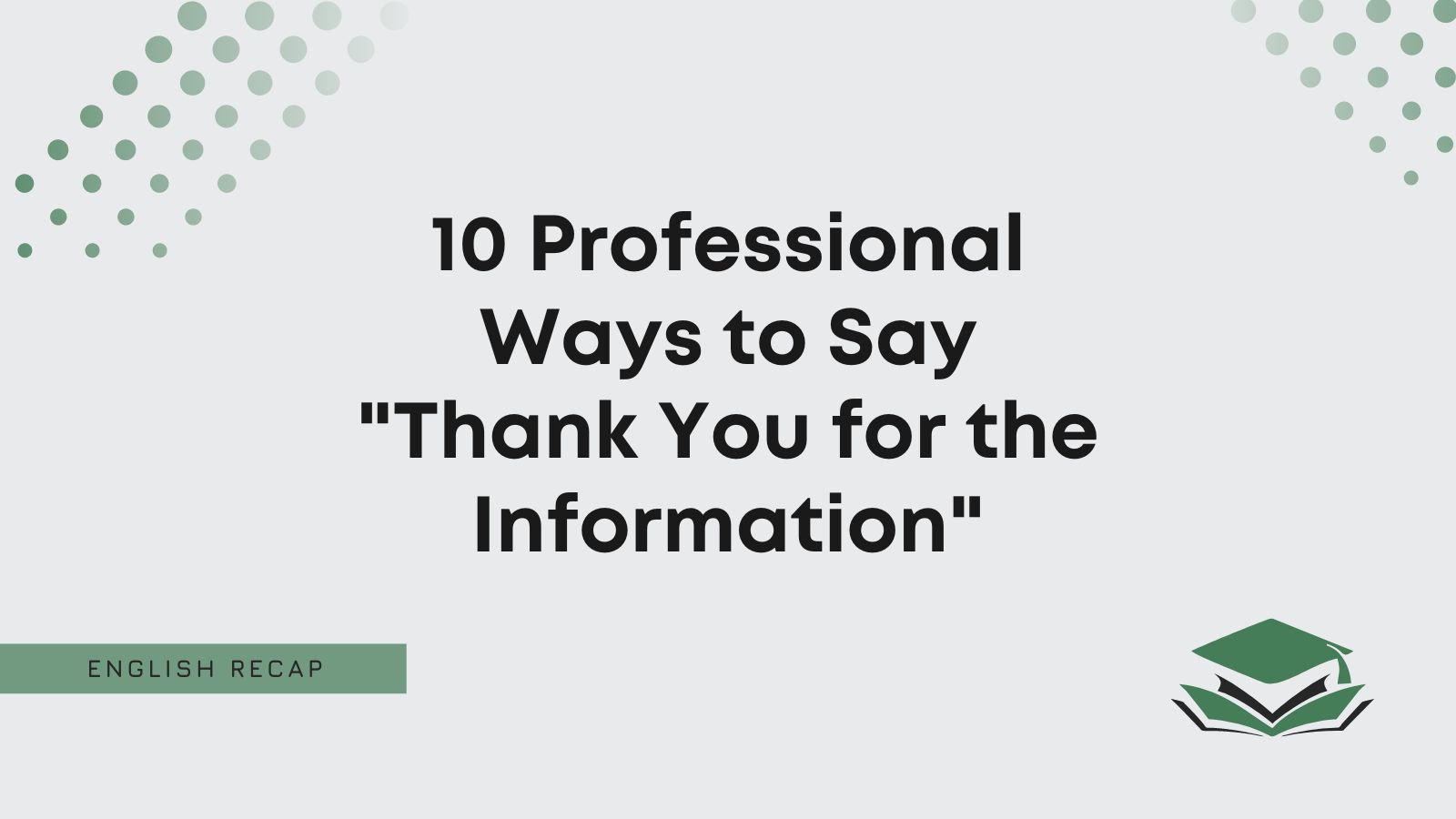Appreciation goes a long way. It’s polite and professional.
Therefore, you should share your appreciation when someone provides an update or information in an email.
You may want to say “thank you for the information.” However, other formal synonyms will help you to branch out. And this article has gathered all of the best ones!
Is It Polite to Say “Thank You for the Information”?
It is polite to say “thank you for the information.” It’s a sincere and professional way to show genuine appreciation when someone provides an update for you.
It’s also a popular choice in formal emails. That’s why we recommend including it to show you’re happy to hear from someone when they provide news.
This sample should help you understand it better:
Thank you for the information. I’ll be sure to relay this to my team to find out their thoughts.
Pros
- It’s polite and appreciative.
- It carries a more formal tone, making it suitable for emails.
Cons
- It’s a bit impersonal.
- It’s overused and generic.
Clearly, “thank you for the information” is one of the best phrases to use in formal emails.
That doesn’t mean you can’t explore some alternatives to mix things up, though.
Keep reading to learn how to say “thank you for the information” in an email. You can also review the examples we provide under each heading.
What to Say Instead of “Thank You for the Information”
- I appreciate the information
- Thanks for providing that information
- I appreciate your sharing this information
- Thanks so much for the update
- Your input has been incredibly helpful
- I’m grateful for your update
- Thank you for enlightening me
- Your update is greatly appreciated
- Thank you for keeping me informed
- Thanks for keeping me in the loop
1. I Appreciate the Information
Using “appreciate” instead of “thank you” is always a more formal choice. Most writers include “I appreciate the information” to sound more formal than “thank you for the information.”
That’s why this phrase works as well as it does. It’s respectful and polite, showing that you’re glad someone chose to reach out to provide you with information.
You should try it the next time a client updates you. After all, it’s best to retain a more professional and friendly relationship with clients (if you want them to stick around).
This email example will also help you:
Dear Ms. Jones,
I appreciate the information, and I await your update. Hopefully, there’s more to share about this discussion soon.
Yours,
Damian Rice
2. Thanks for Providing That Information
Another way to say “thank you for the information” in an email is “thanks for providing that information.”
It’s formal and respectful, showing that you really appreciate someone coming to you.
Generally, this works when thanking your clients. It’s a good way to be honest and thankful when someone helps you out.
After all, clients might provide helpful information about current projects. Whatever the case, if they’ve helped you, it’s best to show appreciation.
Here’s a great example if you’re still unsure:
Dear Ms. Davies,
Thanks for providing that information. I have included it in our case files to help us explore new options.
Yours,
Jules Marten
3. I Appreciate Your Sharing This Information
You have two options with this one. You can write either of the following:
- I appreciate your sharing this information.
- I appreciate you sharing this information.
The difference is subtle and usually comes down to personal preference. Both are formal and polite, though.
Using “your” suggests you appreciate the action itself. So, you appreciate the fact that information was given to you.
Writing “you” is more personal. It suggests you’re thanking the recipient directly for sharing the information.
Whichever you choose, this is a great way to talk to customers. It shows you appreciate them for delivering information to help you.
Check out this sample email as well:
Dear Mrs. Crystal,
I appreciate your sharing this information. Is there anything you need from me that might help here?
Best,
Michael Halpert
4. Thanks So Much for the Update
You should include “thanks so much for the update” as a slightly more friendly alternative. It still works well in business emails, but it’s better to use it when you know the recipient well.
For instance, it’s a good choice when contacting coworkers. It shows how appreciative you are that they reached out to you.
After all, there’s nothing written in the workplace rulebook that says coworkers have to provide you with information. Usually, they would do so because they think it’s relevant or they trust you.
So, it’s always worth thanking someone for trusting you. It’s a great way to show genuine appreciation if they’ve come to you.
We also recommend reviewing the following example:
Dear Harley,
Thanks so much for the update. Please let me know if you come across any more information that might help us.
All the best,
James Perry
5. Your Input Has Been Incredibly Helpful
For a more formal synonym, try “your input has been incredibly helpful.” It works well in business emails because it shows you value someone’s guidance.
Typically, this works when emailing employees. It shows you’re in a position of authority over them without appearing too bossy or dismissive.
It’s a good choice that keeps things respectful. We recommend using it if you’re truly grateful that someone has reached out to give you information.
Here’s a great sample email to show you how it works:
Dear Suzanna,
Your input has been incredibly helpful. I appreciate your update and will use this information to help our cause.
Best wishes,
Dan Hunt
6. I’m Grateful for Your Update
You can write “I’m grateful for your update” as a formal synonym for “thank you for the information.”
It shares positive feelings with the recipient when they’ve provided you with the news.
You can try it when contacting clients. If you were seeking an update from them, this is a good way to show appreciation.
We recommend using it because it shows you care about what your clients say. This keeps things more friendly and civil between you, which should help to retain client relationships.
This email example should clear things up for you:
Dear Mr. Bentley,
I’m grateful for your update. However, I do not think it’ll change much about the original plan.
Thank you so much,
Sean Brent
7. Thank You for Enlightening Me
For a more polite alternative, why not try “thank you for enlightening me”? It’s great to include to show you’re happy to receive information.
In this context, “enlightening me” shows you learned something from the recipient. This works well if you’re trying to share positivity and friendliness with them.
For instance, you can use it when emailing coworkers. It shows you’d like to create a more friendly conversation with them (especially if you’re interested in progressing your relationship).
Perhaps this example will help you understand it:
Dear Zoe,
Thank you for enlightening me. I’m trying to find the best way to move forward with this newfound information.
Best regards,
Tom Allison
8. Your Update Is Greatly Appreciated
We recommend trying “your update is greatly appreciated.” The only thing you need to remember is that it’s a lot more professional than “thank you for the information.”
Since it’s more professional, it doesn’t work well when emailing colleagues.
Instead, use it when emailing clients or your boss. It shows you respect the recipient and want to keep your language as formal and acceptable as possible.
The following sample email should help you with it:
Dear Ms. Young,
Your update is greatly appreciated. I’ll be sure to relay this to the affected parties before we continue.
Kind regards,
Sarah White
9. Thank You for Keeping Me Informed
Information is important in the workplace. The more informed you are, the easier it is to keep on top of changes that happen.
That’s why “thank you for keeping me informed” works so well. It shows you’re happy to hear from someone when sharing new information.
If someone keeps you informed, it means they trust you enough to update you.
This phrase is also quite friendly. So, it’s great to use when you’re happy that someone came to you to share more information.
We also recommend reviewing this example:
Dear Stuart,
Thank you for keeping me informed. I’m so glad to have someone like you working on this team.
All the best,
George Scott
10. Thanks for Keeping Me in the Loop
Finally, you can go back to slightly more conversational language. It keeps your emails engaging and more friendly, which helps to set up a positive conversation.
Try writing “thanks for keeping me in the loop.” It’s still an effective professional choice, but it helps you to sound slightly more friendly when accepting information from a colleague.
Of course, we recommend it more when emailing coworkers. You need to have a good relationship set up with the recipient before using this.
Here’s a great email sample to help you with it:
Dear Martin,
Thanks for keeping me in the loop with this. I knew I could count on you to provide me with this information.
Best regards,
Dan White

